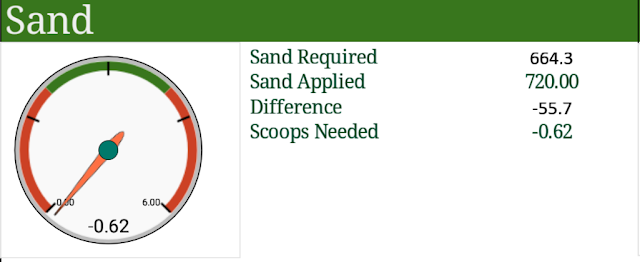This year I changed my approach to topdressing on my greens. I decided to use clipping volume to determine how much and when I would topdress the greens. The idea is that I will apply sand as the grass grows and hopefully eliminate layering from heavy, infrequent sand applications. My nifty HUD knows how much clippings I have removed from my greens and how much sand I have applied to them. It can then display the sand requirement in a way that makes sense to me.
 |
| Sand-O-Meter this morning before applying sand |
 |
| Sand is applied |
 |
| Sand-O-meter is automatically updated after I record my sand application into my online records. |
I have always guessed at how much sand I need to apply which is a big problem. Sand is now the single most expensive input on my entire golf course and I only apply it on greens! ($2000 in previous years with a target of $500 this year) Just like I was guessing how much I aerify, I decided that if I wanted to refine my sand application practices (and be able to adjust them each year in a meaningful way,) I needed to do better.
Just like with fertilizer, water, and pesticides, no two years are the same for their requirements on your golf course. Using dates on a calendar to schedule maintenance practice such as these just doesn't make sense because Mother Nature doesn't give a shit what day of the month is it. If we want to refine things, we need to base our practices on the actual observed conditions.
 |
| a light blow and turn of the heads and they are looking good! |
So after over 6 seasons of collecting and measuring clippings on my greens I have a pretty good idea of how much grass I will harvest. I also have a pretty good idea of how much sand I used to apply.
This is where it gets a bit experimental for me. I'm hoping to reduce thatch accumulation on my greens through careful monitoring of nutrients added vs removed and in theory I hope to keep organic matter production to a minimum but who the hell knows eh?
So, I picked a number that is a lot lower than I have previously applied and will adapt from there. I'm hoping to not have to aerify much or at all so that amount of sand was removed from my numbers. If my chosen annual rate of sand per unit volume of clippings is a bit low, I can adjust it up and if it's a bit high I can adjust it down. In a year where I grow more grass I will automatically apply more sand and in years where there is limited growth I will apply less. Awesome! After a few years I should come to a good number for my course.
The math is simple.
I am applying 227g sand/m^2 per 1g Nitrogen/m^2 removed via clippings. Why this number? I guessed and will adjust it based on soil tests and physical greens properties tests.
To make it more user friendly for me and my staff I converted grams of sand/m^2 into a unit I call "tractor scoops". This is how many scoops are required from the tractor to apply that amount of sand. One hopper in our topdresser holds 2 scoops. Typically a light dusting here will require 4 scoops or 2 hoppers to do. This is an amount that I can apply any day of the week with minimal disruption to golfers but also won't result in me having to apply sand more than once every 3-4 weeks throughout the growing season.
To determine the mass of a scoop of sand you need to first take a scoop of sand with your tractor. Fill a pail with sand and dry the shit out of that sand. Then measure the mass of that pail of sand.
Then see how many pails of sand 1 scoop of your tractor can fill. This entire process took me a half hour. Hint: a tiger torch and a concrete mixer work great for drying sand.
Now you know how much a tractor scoop of dried sand weighs. You also know the volume because you know the volume of that pail right?
For me, one scoop of sand weighs approximately 360 kg when dry.
It is also 228,000 cm^3
1 scoop of sand on 1000m^2 is about 0.23mm thick of sand.
So at the end of the season I will be able to see if that 227g of sand per g of nitrogen removed from clippings is enough and can fine tune my sand applications from there. The ultimate goal is to use as little sand as possible because, hey, it's a non-renewable resource.